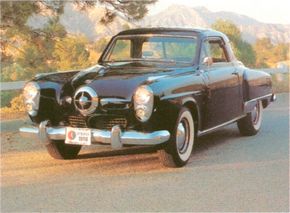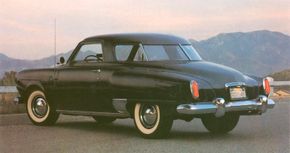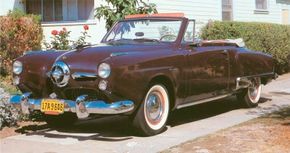Studebaker entered the 1950s riding high. The one-time wagonmaker had been "first by far with a postwar car," the dramatic and dashing 1947 models that attracted customers in numbers unheard of in South Bend, but the next-generation 1950-1951 Studebaker Commander would be the end of the line for the good times.
Advertisement
Despite labor troubles, material shortages, and the drain of heavy investments for new-model development and new facilities, Studebaker built more than 191,000 cars and trucks in 1947, earning more than $9 million in profits.
The following year, volume swelled to nearly a quarter-million units, profits to a record $19 million. Things looked even better in 1949 as sales jumped 30 percent, to about 305,000 vehicles, and profits leaped above $27.5 million.
But troubles were brewing. Though still popular, Studebaker's "New Look" 1947 styling hadn't changed much, and by 1950 it no longer looked so new. Not so the competition, whose first postwar models had arrived in force, mostly for 1949.
South Bend again hoped to move out front with brand-new styling that year, but it was delayed by internal dissension between the Raymond Loewy consultant team and an in-house faction led by designer Virgil Exner, engineer Roy Cole, and production manager Ralph Vail. Studebaker also needed to respond to Big Three initiatives like high-compression V-8s, automatic transmissions, and "hardtop convertibles."
Ultimately, Exner departed for Chrysler, Cole and Vail were diffused, and engineers continued working overtime on the aforementioned innovations. Meanwhile, Loewy staffer Bob Bourke, who'd helped shaped the 1947, came up with one of history's most bizarre face-lifts: the infamous "bullet nose" 1950-1951 Studebaker. It resulted from a personal directive by the French-born Loewy: "Now, Bob, eet has to look like zee aeroplane."
It did, but the record shows it might have turned out better. And though Studebaker called it the "Next Look," nobody rushed to copy it. Still, the new bullet-nose styling helped Studebaker ride the crest of the postwar seller's market to another volume record: over 343,000 cars. Alas, it would never again do so well.
Besides that outrageous front, the 1950 Studebakers boasted an extra inch in wheelbase, reshaped rear fenders, and redesigned instrument panels. More significant was a switch to front coil springs, ousting an antiquated single transverse leaf.
The broad range of Champion and Commander coupes, sedans, and convertibles offered since 1947 gained four closed Champion Customs; starting at $1,419, they returned Studebaker to the low-price field for the first time since 1939.
A half-point compression boost added five horsepower to the old Champ six; Commander's larger six gained 2 horsepower to 102. As befit its higher station, Commander rode a 120-inch wheelbase, seven inches longer than the Champ, and prices ranged from $1,871 to $2,328 for a Regal DeLuxe convertible.
Spring 1950 brought Studebaker's most important postwar engineering advance yet: "Automatic Drive." A line-wide option developed in concert with Borg-Warner's Detroit Gear Division, it was the only automatic transmission designed and built by an independent other than Packard.
And several features made it one of the best anywhere: no-slip torque-converter; a safety that prevented in-gear starting and damage should reverse be accidentally selected on the move; no-creep operation; and a "hill-holder" that kept the car from rolling backward down an incline. Ford wanted to buy Automatic Drive for its cars, but Studebaker refused to sell -- in retrospect, a serious mistake.
To learn about changes or the 1951 model year, continue to the next page.
For more information on cars, see:
- Classic Cars
- Muscle Cars
- Sports Cars
- Consumer Guide New Car Search
- Consumer Guide Used Car Search
Advertisement


